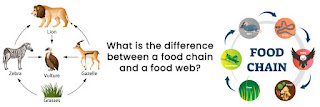Difference between a food chain and a food web
Food chain vs Food web class 10 science
Food chain -
- It is the flow of energy from a low trophic level to a high level in a single straight path.
- It contains a straight chain.
- There is only a linear route of energy and nutrient flow.
- This is increasing as the number of isolated and limited food chains is increasing.
- Collects 4-6 trophic levels of different species.
- Members at high trophic levels eat organisms similar to those at lower trophic levels.
- If only one group of organisms is disturbed, the entire network will be affected.
- Dependency - Typically, a member at a high trophic level depends on an organism at the same or lower trophic level.
- Food chain Examples - Grazing food chain and detritus food chain.
Food web
- These are several connected food chains through which energy flows in the habitat.
- It contains various interconnected food chains.
- There are multiple interconnected pathways through which nutrients and energy flow.
- It grows because of its complex food chains.
- It is a collection of different trophic levels of various species.
- High trophic level members feed on different types of organisms at low trophic levels.
- If a group of organisms gets removed, it will not affect the food web.
- Dependency - In the food web, members at high trophic levels depend on or feed on various organisms at low trophic levels.
- Examples - No type.
Know more types of food chains , food web examples , examples of food chain ,
Tag - What is food chains class 10 ; What is food web ; online class 10 science notes ; School online class ; food chain vs food web diagram

Comments
Post a Comment
Thank you we will contact ASAP.